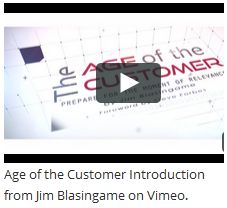 What is our value proposition?
What is our value proposition?
For 10,000 years, during a period I call the Age of the Seller, answering this question was the focus of every business as it went to market. Indeed, customers refined their search for products and services down to the semi-finalist sellers based almost entirely on components of the classic competitive value proposition: price, product, availability, service, etc.
But then something happened.
The Age of the Seller was subducted by The Age of the Customer. In this new era, where value is now presumed, the prime differentiator is no longer competitiveness, but rather relevance. Today the question every business must focus on when they go to market is: What is our relevance proposition?
So does this mean sellers no longer have to be competitive? Not at all—no one will pay you more than they should. But consider four new marketplace truths:
- With value now presumed, customers expect to find what they want, at a price they’re willing to pay, from dozens of sellers.
- They don’t care if they do business on Main Street or cyber-street.
- Prospects are self-qualifying themselves and pre-qualifying a business based on relevance to them before a competitive position has even been established.
- Prospects are doing all of this before you even know they exist.
That last point is perhaps the most breathtakingly disruptive development in the shift to the new Age. As this shift plays out, two types of sellers—Hidebound and Visionary—currently exist in parallel universes, but not for long. Which one are you?
Hidebound Sellers
These companies are so invested and entrenched in the old order of control that they deny the reality in front of them. They can be identified by the following markers:
• Misplaced frustration: As performance goals get harder to accomplish, frustration makes those who deny the new realities think their pain is caused by a failure to execute.
• Bad strategies: It’s said that armies prepare for the next war by training for the last one. So it is with Hidebound Sellers. While Age of the Customer pressure makes them think they’re being attacked, they persist in using Age of the Seller countermeasures.
• Destructive pressure: Convinced of execution failure, pressure brought to bear by management results in an employee casualty list and a shrinking customer list.
• Equity erosion: Defiance in the face of overwhelming evidence sustains the deniers until they run out of Customers with old expectations, and their equity and access to credit are depleted.
Visionary Sellers
These sellers are adjusting their plans to conform to the new reality of customers having more control. Visionary Sellers are identified by these markers:
• Acceptance: They accept that customers have new expectations about control and make adjustments to this reality.
• Modern sales force: They hire and train their sales force to serve increasingly informed and empowered customers.
• Technology adoption: They offer technology options that allow customers to find, connect, and do business using their expectations and preferences.
• Relevance over competitiveness: They recognize that while being competitive is still important, it’s been replaced in customer priority by the new coin of the realm: relevance.
• Special sauce: They combine and deliver high touch customization with high tech capability.
In The Age of the Customer, Hidebound Sellers are dinosaurs waiting for extinction. Visionary Sellers are finding success by orienting operations and strategies around a more informed and empowered customer seeking relevance first.
Write this on a rock … What’s the verdict? Are you Hidebound or Visionary?




